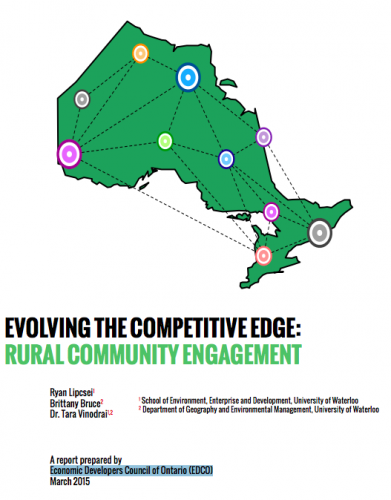Recognizing the importance of Ontario’s Rural Communities, EDCO has featured rural related sessions for attendees at the last 2 EDCO conferences in 2014 and 2015 respectively. Through EDCO’s partnerships with the Rural Ontario Institute (ROI) and the Ontario Ministry of Agriculture, Food and Rural Affairs (OMAFRA) these concurrent sessions drew over 100 participants. The 2015 session was specifically focused on how community leaders and economic development professionals could deepen their level of community engagement and the benefits that would result.
The following report will be a valuable resource for all EDCO members regardless of their size. “There are some great best practice examples found in the report that most members will be able to transfer to their own jurisdictions” states, Heather Lalonde, CEO for EDCO. “The Rural Community Engagement document was completed by an excellent team of volunteers. Their dedication of endless hours towards research, writing and editing are greatly appreciated. A special thank you goes out to the University of Waterloo Local Economic Development program for their contribution as facilitators at the session and as authors of the following report.”
Read more
Download Evolving the Competitive Edge
INTRODUCTION
From February 10-12, 2015, the Economic Developers Council of Ontario (EDCO) hosted their annual conference at the Hamilton Convention Centre. Building on the success of a session on rural economic development held in the previous year, the organizers in collaboration with the Rural Ontario Institute (ROI) and the Ontario Ministry of Agriculture, Food and Rural Affairs (OMAFRA) held a session entitled “Rural & Small Communities – Evolving the Competitive Edge: Rural Community Engagement.”
The session was designed to facilitate sharing about how to deepen levels of community engagement in economic development activities. Participants had the opportunity to join roundtable discussions to share success stories, resources and tools; discuss barriers to engagement; and to brainstorm solutions. This report provides an overview of the session and offer a synthesis of the key findings and outcomes produced through the discussion.
COMMUNITY ENGAGEMENT
Lisa Attygalle, Director of Engagement from the Tamarack Institute kicked off the session with a lively discussion of community engagement and how we should (and should not) do it. Attygalle argued that community engagement is successful only when we are equipped with good information. And, good information draws upon our collective wisdom. Using the metaphor of a scallop, she explained the importance of collective wisdom. A scallop has eyes that cover all 360 degrees of its surroundings and it benefits from bringing all of these perspectives together. Of course, she noted, when it comes to community engagement, the vision of the scallop is aspirational; the reality is that community engagement often involves the same ten people in the community. This is problematic. These ten people do not necessarily represent the community as a whole nor do these ten people represent a diverse set of viewpoints.
Essentially, it is the group of people who happen to be available at 2pm, Attygalle quipped. However, Attygalle warned, this is only part of the reason that economic developers and other community builders access sub-optimal information when doing community engagement. Another reason relates to the venues we choose (e.g. council meetings) and the nature of the formal announcements we make. Imagine, she noted, if Nike approached its product announcements in the same manner that public meetings are announced. Practitioners involved in community engagement should take a cue from the well established fields of advertising and marketing. In short; we should ask ourselves, what would Don Draper do? In the world of marketing and advertising, knowing your target market is critical for success. Certainly, when doing community engagement, we need to know our audience.
Understanding who is in the crowd is a critical first step to gathering meaningful input. Moreover, in the case of community engagement, that audience is a group of individuals with some shared perspectives and some different interests. Attygalle invoked a series of rules to communicate with and maintain your audience when engaging with communities.
- The 7 second rule – You have seven seconds to grab the attention of your audience;
- The 7 minute rule – Your audience has about seven minutes of their time to give to you;
- The 7 bit rule – Your audience will likely remember only seven pieces of information. They will be best remembered if they are grouped together in meaningful ways;
She emphasized the power of visuals to enhance the experience for the audience, as well as to get and keep their interest. For example, the recent ‘Feeling Congested’ campaign by the City of Toronto offered a more visually appealing and effective way of engaging with transit users on the issue of public transportation. Similarly, the ‘Meet Jean Bosco’ campaign by charity: water personalized stories about water access and harnessed social media to raise funds in a unique and powerful way reaching more than six million people. Attygalle emphasized that it was critical to harness your audience’s emotions since an emotional engagement is more likely to remain in your audience’s long term memory.





